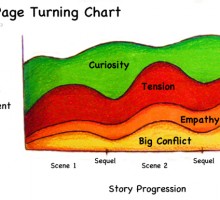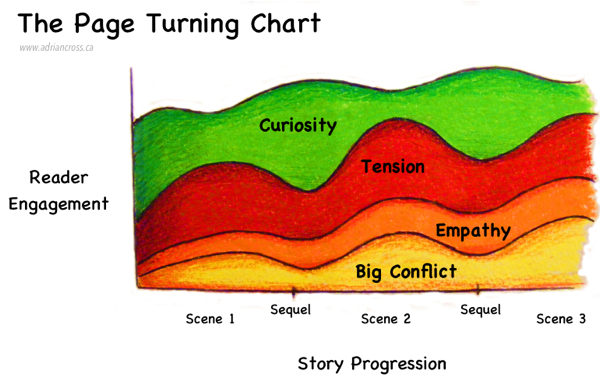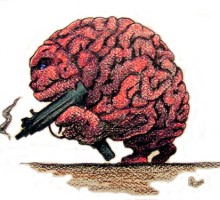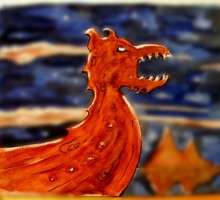(Ignore the graphic for now, we’ll get to it later)
Like mixing rocket fuels for the big takeoff, getting the right mix for your story beginning is important, but not necessarily formulaic. And we all want to avoid the fizzling dud. The two of the most powerful elements for beginning pages are curiosity (without confusion) and tension (clear goals and obstacles both, creating tension in both character and reader).
But first, why these two?
Why not empathy?
One of my first agent interactions stressed empathy (the agent telling me to consider this before sending her the full manuscript). The need to have the reader relate to your character. And she was right. But this advice is less relevant to the very first pages. Why? Simply put, there’s not enough time.
You need a way to bridge the gap between the early pages and the later ones. Empathy takes time to build. You do probably want to have a ‘save the cat’ moment at some point *. But well before then, you’ve got to hook the reader, or you’ll never get to that point.** You don’t have time to meander around showing the reader how nice a person the character is, without something else going on. You need them flipping pages!
Well then, why not Big Conflict?
Why not crash a few armies together and have heads roll around underfoot, making people trip on their own swords?*** Surely that will hook a reader?
Well, maybe. But likely not. Because it’s confusing. Without empathy (which we’ve established isn’t there yet), the reader doesn’t care terribly about the outcome for the character, and so the stakes are low–which isn’t a recipe for gluing eyes to the page. That’s not to say that you can’t start a story with big conflict, if you’re clever and include a touch of curiosity. 🙂 For example: if a fifty foot onyx statue rises out of the ocean and crushes the seaside castle, but takes only one small serving girl and disappears back into the waters****, that is Big Conflict, but with enough intriguing ‘what if’ questions raised that you could probably get away with it (why the serving girl? Where did the statue come from and why is it stomping a perfectly good castle into a pebbly pile?)
Curiosity:
This one is key, I believe, especially for unestablished writers. Curiosity not only killed the cat, it got a lot of agents and editors and readers to turn pages, even if they weren’t sure where the author was taking them. Even if they didn’t immediately like the character, or setting, or even elements of the writing style. Many things are overlooked for a page-turning story.
But not Confusion!
It’s a fine line to walk–between curiosity and confusion–and one I miss consistently and need many critique reads to pull me back from. You need enough information to ground the reader in time, place, goal, and obstacle (or all but one of them, if that’s the element that you’re trying to keep up your sleeve). Opening a scene in white space, where you don’t know who’s talking, where they’re talking, or why they’re talking, is not the type of curiosity you’re going for!
But what if, as an example, your opening has a little girl aiming a revolver at a policeman in a dusty basement, and she tells him that the only way she won’t shoot is if he shows his true shape…? The questions raised are intriguing, and don’t detract from a reader’s understanding of the character’s setting and goals. They just don’t know motivation and context, which can be revealed more slowly. There is also a chunk of tension in this scene (will she pull the trigger or won’t she?) which is nice, even if it’s not a bang ‘em up shootout.
Later in the story, as empathy builds, curiosity tends to be more useful for scene and chapter breaks, and becomes less important on an ongoing basis. But in the first few pages, it’s crucial, especially for new writer with no established readership and the related goodwill. As Brandon Sanderson points out, his readers give him a lot of leeway because they know how he writes and like his stuff (for example, slow magic system and world-building development) so they know where he’s going and trust him to give their patience the proper pay-off. For you and me, not so much. Not yet. 🙂 This problem is especially true with jaded editors. To get them to turn the pages, you need them to read on despite a sincere intention to put your pages down (or hit auto-reject) at the first excuse and move on to the other million emails blinking at them from their inbox. Curiosity is a powerful way to catch and keep their attention, despite themselves.
Tension:
I know I said Big Conflict isn’t great. But tension is something different. It’s more subtle, more around the edges of a scene. And it is very powerful. If you have a character with a clear goal, a clear obstacle, and a face off between the two, you’ve got tension, even if it’s just in conversation. And you also have a fairly good chance that the reader will stick around to at least find out how the immediate scene goal resolves.
So let’s give an example. Let’s say in your opening pages, you have a thin, pale-faced man show up at a drug lord’s den, dark trench coat trailing, pungent alley behind him. He says he’s come for his brother. Facing him are two muscle-bound bouncers with guns in their waistbands and a heavy steel door behind, that would take dynamite to budge. They grin unpleasantly. Two more bouncers step threateningly behind the man, boxing him in.
There are some questions here, but they’re on the margin (mostly, what makes this guy think he has a prayer of succeeding? Or is he just delusional and about to be squelched? The reader probably also suspects that the man is hiding something under his trench coat, and if so, what?). Mostly though, this is just tension. They guy wants in, a clear goal. The bouncers have no intention of letting him past, a clear obstacle. You can almost smell the confrontation coming. Many readers will keep reading just to see how this resolves, for better or worse. If you keep twisting and surprising in your story line, you can keep this going for a while, without necessarily having a fight break out.
BUT, while you can lean on tension by itself, it’s interesting to see how it becomes even more powerful when partnered with curiosity. So let’s return to the same example:
What if I added that the thin man has an expression of pain on his face? That his body is hunched and face twitching as if something is trying to claw its way out of his body, sweat sliding down his cheeks? The bouncers look uneasy.
Okay, now even I’m curious. There is more going on now than appears on the surface. Is the man going to shape change? Collapse? Turn a glowing red-veined yellow? I’d turn a page or two more to find out the answer to that minor mystery. And give the author the chance to build some empathy along the way. And conflict. And world building. And all the other good stuff that makes a satisfying story package, but doesn’t necessarily help out in the first few pages.
So, finally, in Pictures:
Because I’m a visual person (shocking, I know, given all the art on the website) I figured I’d draw a picture. 🙂
The bottom yellow band is the traditional story arc, the rise and fall of conflict. But I think that I’ve made the point by now that you can’t wait for the later pages to hook a reader. The gap of the yellow and orange bars early on need to be filled with green and red, curiosity and tension, to snag the attention of readers and agents, and keep them reading. Unless you’re a big name author who already has a hard core fan base, like Brandon Sanderson. In which case, I have a manuscript I’d like you to blurb. 🙂
In Summary:
I hope that some of this helps with your openings. Curiosity and Tension. Powerful beasts, that you can harness to your story’s benefit, especially in the opening pages. I know I’m planning to focus more on this for my own future works. Because I want to pour a double jug of rocket fuel into my story and blow a hole in that dratted moon.
Or have a pair of dark wings explode out from my thin ordinary-looking character, and show those bouncers why they should have stayed in bed that day! 🙂
________________________________________
* Blake Snyder’s screenwriting book ‘Save the Cat’ suggests having a character do something early on that makes the reader like them, like his famous example of saving a cat. This helps build empathy.
** For full disclosure, many of my earlier stories, even the ones I like, don’t have this insight in them. It will be something I have to fix in the pieces that I’d like to rework, and honestly, it’ll probably be harder to do in revision than if I’d known this earlier and mapped out the story properly. Oh well.
*** An easy mistake to make—starting with big conflict, not falling on my own sword–and one I’ve been prone to doing, even recently. Hey, I like action. 🙂 So take this as a well earned and reluctantly conceded admission.
**** My idea, hand’s off! Stomp, stomp, stomp. 🙂
As noted, this image was created for the post, to help illustrate my point. I kind of like this concept and may build on it later. Not to toot my own horn, but I haven’t seen things presented quite this way, visually, before, and I think it helps make the concept a little more concrete, particularly how different story elements can have different emphasis through the story.



